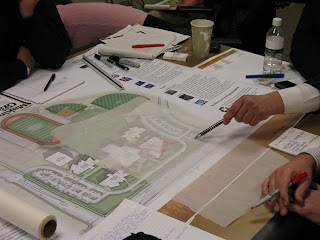The Institute for the Built Environment is very proud to announce that grant funding has been secured from CSU's School of Global Environmental Sustainability and UniverCity for the establishment of an Urban Laboratory on the CSU campus in Fort Collins. Temporary space has been secured at The Institute for the Built Environment on campus near the corner of Mason and Laurel streets, with the aim to eventually secure permanent space on or near the Mason Street corridor. The UniverCity Urban Lab steering committee is in the process of defining the UniverCity Urban Lab, with the aim of the establishment of a 501c3 non-profit organization to embody the values of community members and stakeholders that it draws upon for the generation of ideas and input.
 |
| Mason Street Corridor, Fort Collins |
But what exactly is an Urban Lab? An Urban Lab is an adaptive forum that includes a variety of stakeholder input, which can include community members, professionals, academics, policy-makers, designers, artists and developers. Interested parties collaborate to brainstorm solutions and interventions for issues and opportunities that the urban community shares. The platform ideally acts as a think-tank to propose ideas and visions and to propose, test, design and implement collaborative urban planning projects that answer to a variety of community desires and needs. It is, quite simply, a laboratory to test ideas that will be applied at an urban level.
The mission statement of the lab at this juncture is simple: “The Mason UniverCity District is a dynamic area ripe for redevelopment. The district and its multi-modal transportation focus models a robust and eco-friendly mix that supports residents, business, retail and entertainment. It is vibrant and draws people from throughout the community and University to come live, work and play. It is a connector inviting exploration of the eclectic District as well as adjoining neighborhoods and nearby destinations. It is another of Fort Collins’ jewels”.
The aim of The Lab is to guide the Mason Street Corridor toward vibrant and regenerative infill projects. This initiative dovetails with the proposed 2014 opening of the MAX bus mass rapid transit system. The studies and projects will focus on urban design at various scales, urban morphology, neighborhood planning and design, and health and the built environment, all with a particular focus on walkability, bike-ability and an ethos of urban biodiversity and ecology.
 |
| MAX Transit Station Rendering, Mason Street Corridor City of Fort Collins |
Of course, other relevant urban design and development topics are likely to arise with the eclectic mixture of the stakeholders, community members, professionals and educators that The Lab is bringing together and drawing from. With the continued support and evolution of The Lab, the development of catalytic projects along the Mason Street corridor will grow a more robust physical, virtual and philosophical connection between the CSU campus, Old Town Fort Collins, and the communities therein. The implementation of our goals will enhance pending development and transportation projects and, with luck, creativity and application, will positively affect the fabric of the Fort Collins community.
To see the work of a small selection of other Urban Labs, please follow the following links:
The Carnegie Mellon Remaking Cities Institute
The Dallas Urban Lab
The California College of the Arts Urban Lab
Arcosanti


